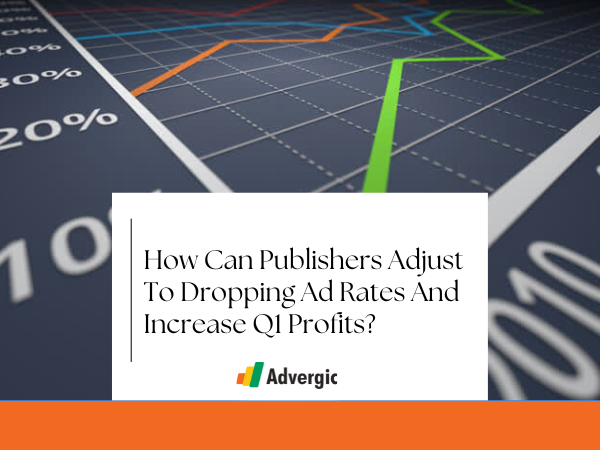Publishers are likely acquainted with the yearly decline in ad rpm that happens at the start of the year. Non…
Publishers are likely acquainted with the yearly decline in ad rpm that happens at the start of the year. Nonetheless, your earnings may differ significantly if you comprehend these variations and know how to adjust. In this post, we’ll examine the options accessible to publishers.
Let’s examine past trends in ad rpm: Ad rpm typically decrease at the conclusion of each quarter as well as at the end of each month. Every year, around the end of December, there is the biggest decline.
Publishers should be aware of this historical trend in order to prevent unwarranted anxiety or alarm in the event that ad rpm decline. This is a common occurrence in the industry and isn’t a reflection of a problem with your site or traffic. Publishers often mistakenly believe that traffic problems or personal websites are the cause of revenue declines.
Google, a major force in the ad revenue market, is one of the bid partners included in the Online Ad Revenue Index. It gives publishers a quick overview of the state of the industry’s ad pricing. Publishers can ascertain if a decline in ad revenue is unique to their website or a result of a wider market trend by consulting the Ad Revenue Index.
It is evident through multiple sources that ad rpm consistently decline sharply in January of each year. Given that ad rpm typically peak in the fourth quarter, the decline is particularly significant given the significant shift in trends from December to January.
For what reason does this occur? Advertisers often have a “use it or lose it” budget, which means that their spending won’t carry over into the following year. Since budgets are reset on January 1st, marketers are usually more strategic about their advertising spend at the beginning of the year.
Ways To Reduce The Ad RPM Drop
Even in situations where ad prices are declining, publishers can take a number of proactive steps to maximize their earning potential.
Increasing the Usability of Current Websites
We suggest that in order to lessen the effects of ad rpm declines, it is crucial to optimize already-existing sites. You can utilize various tactics, such as:
Theme Alterations: Changing or upgrading a website’s theme can enhance user interaction and produce new, high-value ad spaces like sidebars. These high-visibility ad placements can contribute significantly to revenue.
Page Loading Speed: Improving page loading speed can increase engagement on your website. A fast loading website gets more visitors than a slower website.
Optimized Ad Placements: Nobody likes a site with more ads than content. Visitors often leave the website if they find irritating ad visibility. Optimizing your ad inventory and ad placements can help publishers like you to increase ad revenue as well as user’s engagement.
Acquire Advergic’s Help: Advergic, being an ad tech solution for publishers like you can help you optimize your existing ad placements. Switching to Advergic can boost your revenue up to 400%. Our experts optimize your ad inventory, bidding strategies, ad delivery and other ad ops to increase your ad revenue.
AI and Content Creation
Ever wonder how revenue can be increased by using AI-driven content production tools? These tools help publishers to create content in short time. With proper prompts and premium packages, this technology enables publishers to use AI support to create engaging content while retaining their voice.
Making Videos and Using Schema Markup
Publishers are finding that making videos is a profitable option. Making videos from articles is made easier with the help of apps like Flickify. This expansion has the potential to draw in more customers and raise income.
Schema markup is also advised for increasing click-through rpms and search engine exposure. By offering more thorough information in search results, publishers can increase user interest in their material.
Diverse Traffic Sources
Increasing the variety of your traffic sources helps you become less dependent on any one source. To grow their readership and revenue streams, publishers need to look into social media, forums, and additional channels. Diverse traffic sources protect against abrupt algorithmic changes that can affect a major source of traffic.
Looking Into Other Possibilities
Publishers can explore extra revenue-generating opportunities like:
Facebook Revenue: To increase their income, publishers can investigate Facebook’s payment scheme.
Affiliate Marketing: By using affiliate links and marketing, publishers can bring in extra money.
Launching New Websites: Establishing new websites in various niches offers opportunity for money generation and diversification.
Using Big Data Analytics: Publishers can find high-earning content and refine their approaches by utilizing big data analytics.
Conclusion
A thorough approach is necessary for publishers looking to maximize Q1 profitability. Publishers can effectively navigate ad rpm by learning about the past trends in ad rpm fluctuations, utilizing resources such as the Ad Revenue Index, optimizing current websites, adopting AI-driven content creation, integrating video and schema markup, broadening their traffic sources, and looking into new opportunities. By using these tactics, publishers may increase revenue, respond to changes in the market, and establish a strong online presence. For more information you can visit our blog section. If you are interested in increasing your ad revenue then contact us and our experts will help you boost your revenue.
Have questions about Header bidding wrapper and price granularity?
Schedule a free consultation with our Header Bidding Expert today 📞

